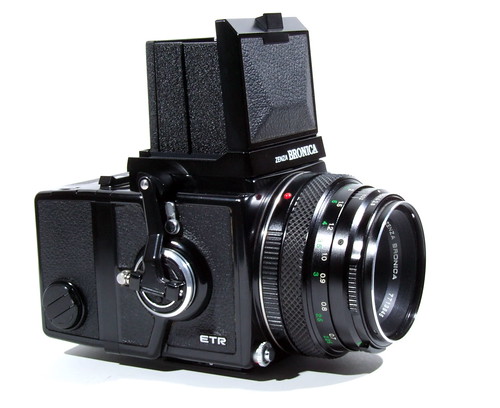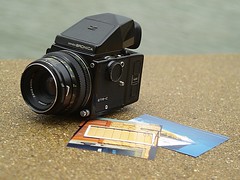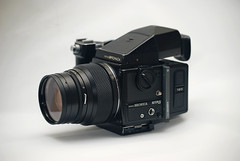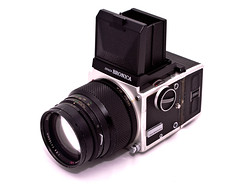Difference between revisions of "Bronica ETR"
m (→Chrome bodies and accessories: misc) |
(added chrome ETRS photo) |
||
| Line 81: | Line 81: | ||
== Chrome bodies and accessories == | == Chrome bodies and accessories == | ||
| − | + | {|class=floatright | |
| + | || | ||
{{Flickr_image | {{Flickr_image | ||
|image_source= http://www.flickr.com/photos/drg46/6334940079/in/pool-camerawiki/ | |image_source= http://www.flickr.com/photos/drg46/6334940079/in/pool-camerawiki/ | ||
| Line 90: | Line 91: | ||
|image_rights= with permission | |image_rights= with permission | ||
}} | }} | ||
| − | + | |- | |
| + | || | ||
| + | {{Flickr_image | ||
| + | |image_source= http://www.flickr.com/photos/37079676@N03/6822259850/in/pool-camerawiki/ | ||
| + | |image= http://farm8.staticflickr.com/7047/6822259850_c2bb73e9c8_m.jpg | ||
| + | |image_align= right | ||
| + | |image_text= chrome ETRS | ||
| + | |image_by= Ray Kasal | ||
| + | |image_rights= with permission | ||
| + | }} | ||
| + | |} | ||
Since introduction, the ETR series has been produced in chrome<ref>[http://www.butkus.org/chinon/bronica/bronica_etr/bronica_etr-splash.htm An ETR manual that shows the original chrome components of the system is available online.] at [http://www.butkus.org/ butkus.org].</ref>. Bronica made chrome ETR and ETRS bodies, along with chrome 120, 220, and 70mm backs probably until 1981 when they switched from metal body panels to polycarbonate. There were never any chrome metal finders, though most of the pre-1981 finders seem to have been black painted metal just like the standard black bodies. This odd combination of colors might seem unusual, but all of them look good and work well together with the other standard black components. | Since introduction, the ETR series has been produced in chrome<ref>[http://www.butkus.org/chinon/bronica/bronica_etr/bronica_etr-splash.htm An ETR manual that shows the original chrome components of the system is available online.] at [http://www.butkus.org/ butkus.org].</ref>. Bronica made chrome ETR and ETRS bodies, along with chrome 120, 220, and 70mm backs probably until 1981 when they switched from metal body panels to polycarbonate. There were never any chrome metal finders, though most of the pre-1981 finders seem to have been black painted metal just like the standard black bodies. This odd combination of colors might seem unusual, but all of them look good and work well together with the other standard black components. | ||
| Line 97: | Line 108: | ||
Confusingly, there was a later, champagne chrome colored polycarbonate 40th Anniversary edition that also includes matching AE-III Finder, Speed Grip, and 75mm lens. This set uses grey instead of black leatherette. It is very pretty and Bronica used its great original type and logo from the 60s-- but it does not match any previous silver chrome components.<!-- what does this mean? chrome plating? --> | Confusingly, there was a later, champagne chrome colored polycarbonate 40th Anniversary edition that also includes matching AE-III Finder, Speed Grip, and 75mm lens. This set uses grey instead of black leatherette. It is very pretty and Bronica used its great original type and logo from the 60s-- but it does not match any previous silver chrome components.<!-- what does this mean? chrome plating? --> | ||
| + | {{br}} | ||
== System == | == System == | ||
See [[Bronica_lenses#ETR_6x4.5|Bronica lenses]] for available lenses. | See [[Bronica_lenses#ETR_6x4.5|Bronica lenses]] for available lenses. | ||
Revision as of 16:06, 13 April 2012
The Bronica ETR is a series of 4.5×6 SLRs made by Bronica.
Contents
ETR
The ETR was released in 1976 and is Bronica's first leaf shutter based camera system. Their previous cameras used focal plane shutters, with Nikon manufacturing the optics. After losing Nikon as a partner, Bronica initially tried to contract out manufacturing of lenses to Tōkyō Kōgaku, Carl Zeiss Jena and other companies, but decided to begin designing and producing their own optics. Their main competing camera at the time was the Mamiya M645.
The ETR lens system has a Seiko manufactured electronic shutter with speed of 8 sec. to 1/500 sec. plus T. A mechanical shutter setting of 1/500 sec. is also available. The mechanical setting does not use any battery power. Since it's a leaf shutter based camera, flash sync is available at all speeds. An interchangeable back system was incorporated that has the ability to use a 120 or 220 (15 / 30 ) exposure film backs. Changeable backs make the system more flexible compared to the original M645. After the shutter is fired and a frame is exposed rotating the film advance lever one rotation resets the mirror, advances the film and cocks the shutter. The ETR series adopted some of the dark slide features of previous models. The camera will release the back when the dark slide is inserted and pressed. The shutter cannot be released with the dark slide inserted. Unlike the older Bronica models, when the back is detached from the body the dark slide can still be removed from the back.
The shutter cannot be cocked without film, but use of multi-exposure mode can cock and test fire the shutter. The lens cannot be removed or attached without cocking the shutter. Observe the cocking pin colour is green on the lens and body before attaching or removing the lens. This is because the mirror does not automatically return and has to move out of the way. The camera is powered by a 6v PX28 battery with a battery check feature also available.
ETRC
The ETRC released in 1977 is almost the same as the regular ETR, the only major difference is that the back is not removable, but uses inserts. While mid-roll film format changes are not possible, end of roll changes are just as quick with additional inserts. The naming of this model is similar to to the original Bronica 6x6 series where the Bronica C did not have interchangeable backs.
ETRS
The ETRS is an improved version of the ETR. The main improvement is the interchangeable viewfinder system. The newer AE II and III finders are not fully compatible with the older ETR cameras, because there is a new electronic connector pin.
ETR-C
The same specifications as the ETRS but without the interchangeable backs. Not to be confused with the Bronica ETRC.
ETRS (second revision)
A revision of the ETRS was made, that replace the body to a newer plastic shell. The specifications of the camera remain unchanged. The only functional difference is the shutter button lock.
ETRSi
The Bronica ETRSi is based on the second revision of the ETRS. It has a number of new and improved features. New features include mirror lock-up switch located near the film winding crank. TTL flash metering with OTF flash exposure feature. TTL automatic flash requires the use of the SCA connector located on the shutter side of the body for attachment to a SCA flash adapters. When multiple-exposure mode is enabled, the right of the viewfinder now displays an red indicator. A traditional bulb mode shutter setting is available instead of just T, but it drains power while in use. The film advance gearing mechanism has been improved. The film back EI has been improved with locking dark slide system similar to the older 6x6 Bronicas.
Gallery
| ||||||||
|
|
|
ETR series special editions
- 20th Anniversary ETRS (probably 1979): Matching body, 120 back, and AE-II finder in black painted metal with brown leather.[1]
- ETRS Clubman (perhaps 1980 with the introduction of the SQ system): Matching body and AE-II finder in black painted metal, silver Clubman name plates, and lower rubber side panel reminescent of the newly introduced Bronica SQ camera system.
- Safari ETRS (sometime between 1982 and 1988): a surprisingly complete color-coordinated system with ETRS body, 75mm lens, 120 E back, AE-II finder, waist-level finder, speed grip, professional lens hood, and system case in green (possibly painted) polycarbonate with tan leather and accents. [2]
- “William Fox Talbot the 150th Anniversary Special Edition” ETRSi (1990): Standard black polycarbonate ETRSi body with gold plaque below the shutter speed dial. Also came with Billingham Talbot 150 Year Hard Equipment Case (Holds Body, 2 Backs, 3 Lenses, Flash, Finder, and Motor Grip)
- “300,000 ETR Series Cameras Sold” ETRSi (Chrome Limited Edition, 1996): Matching body and 120 back in silver chrome polycarbonate with fine-grained black leather.[3]
- 40th Anniversary Limited Edition ETRSi (1999): Matching body, 75mm PE Lens, 120 Ei back, AE-III Finder, and Speed Grip all in champagne chrome polycarbonate (plastic) with grey leatherette— even the lens barrel is polycarbonate.
Chrome bodies and accessories
| ||
|
Since introduction, the ETR series has been produced in chrome[4]. Bronica made chrome ETR and ETRS bodies, along with chrome 120, 220, and 70mm backs probably until 1981 when they switched from metal body panels to polycarbonate. There were never any chrome metal finders, though most of the pre-1981 finders seem to have been black painted metal just like the standard black bodies. This odd combination of colors might seem unusual, but all of them look good and work well together with the other standard black components.
Then in 1996, Bronica produced a Chrome Limited Edition ETRSi body with matching Ei 120 back. This was different from the original ones in several ways. First the originals came with chrome winding cranks, while the Chrome ETRSi came with a standard black crank. Second the original 120 backs had chrome shells and inserts, while the 1996 chrome backs were black painted shells with chrome inserts. There are a few more black parts that are easily replaceable from any ETR or early ETRS parts bodies. These include the multi-exposure lever, mirror lock-up lever and the winder cover [5]. Doing so makes a thoroughly modern ETRSi body reminiscent of the Bronica S and S2 series -- and more importantly gives a very rugged, compact, modern medium format body.
Confusingly, there was a later, champagne chrome colored polycarbonate 40th Anniversary edition that also includes matching AE-III Finder, Speed Grip, and 75mm lens. This set uses grey instead of black leatherette. It is very pretty and Bronica used its great original type and logo from the 60s-- but it does not match any previous silver chrome components.
System
See Bronica lenses for available lenses.
|
Finder
Film
Flash
|
Focus screens
Body
Lens
|
Notes
- ↑ See this page of Koh's Camera website.
- ↑ See this page of Koh's Camera website.
- ↑ See this page, this page, and this page in Raymond Bradlau's pbase Camera gallery.
- ↑ An ETR manual that shows the original chrome components of the system is available online. at butkus.org.
- ↑ See Raymond Bradlau's photos referenced above for a pleasant example of mixing the 1996 chrome ETRSi with the older components.
Bibliography
- Lewis, Gordon, ed. The History of the Japanese Camera. Rochester, N.Y.: George Eastman House, International Museum of Photography & Film, 1991. ISBN 0-935398-17-1 (paper), 0-935398-16-3 (hard). P. 150.
- McKeown, James M. and Joan C. McKeown's Price Guide to Antique and Classic Cameras, 12th Edition, 2005-2006. USA, Centennial Photo Service, 2004. ISBN 0-931838-40-1 (hardcover). ISBN 0-931838-41-X (softcover). Pp. 159–62.
Links
General links
In English:
- Bronica Users Group (BUG) at the Yahoo Groups site
- ETRSi Specifications and PE Lens Series Information at the Tamron Japan official website
- Bronica Discontinued Products List at the Tamron Japan official website
- Bronica ETRS/Si at medfmt
- Excel spreadsheet listing complete ETR lens production from 1976 - 2004 at Jonathan Taylor's personal webspace.
- Bronica ETR website at myphotoweb.com (also in Dutch)
In Spanish:
In French :
In Japanese:
User manuals
- Bronica manuals at the Tamron official website, including the ETRS and ETRSi
- Bronica ETR manual and Bronica ETRS / ETRC manual at butkus.org






